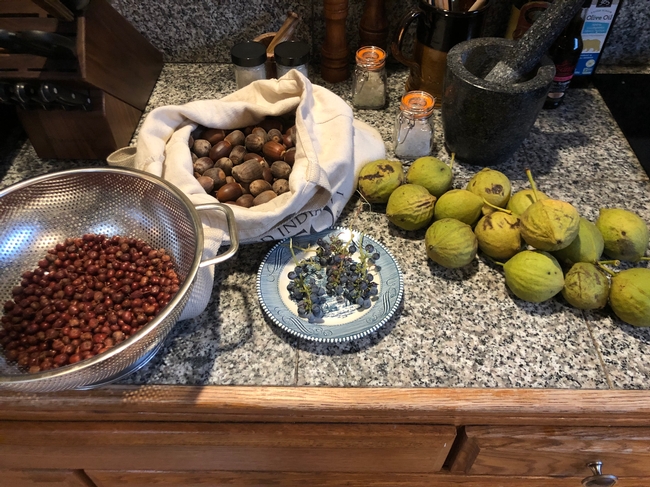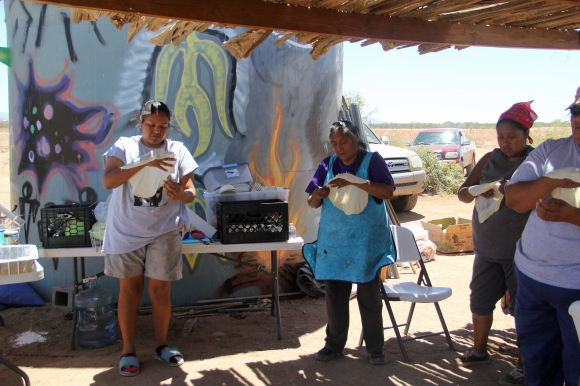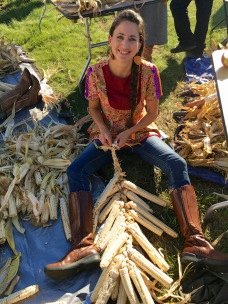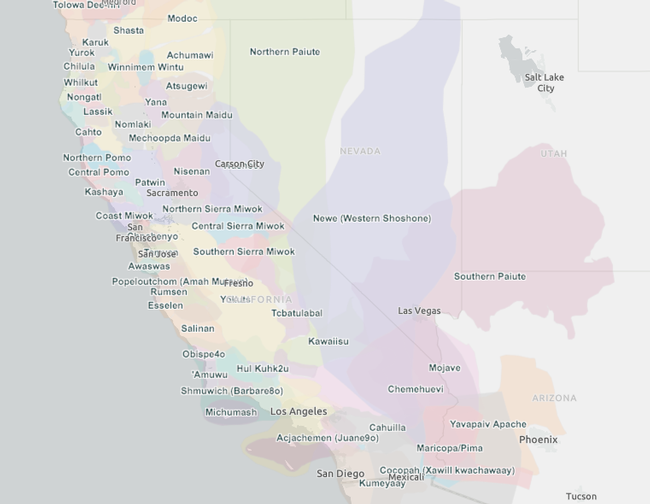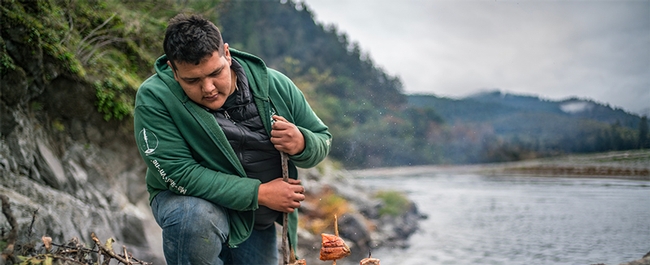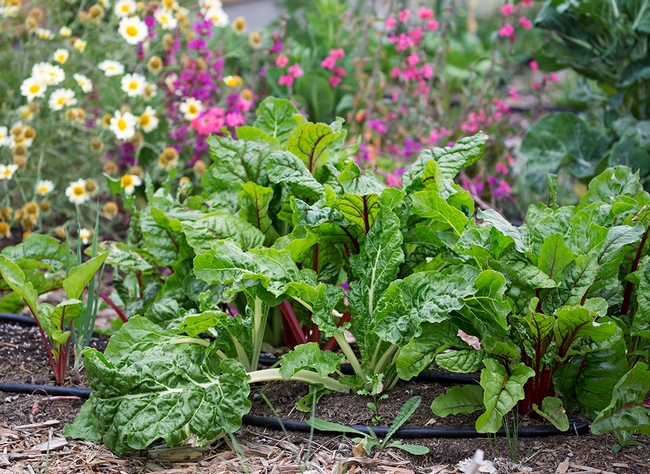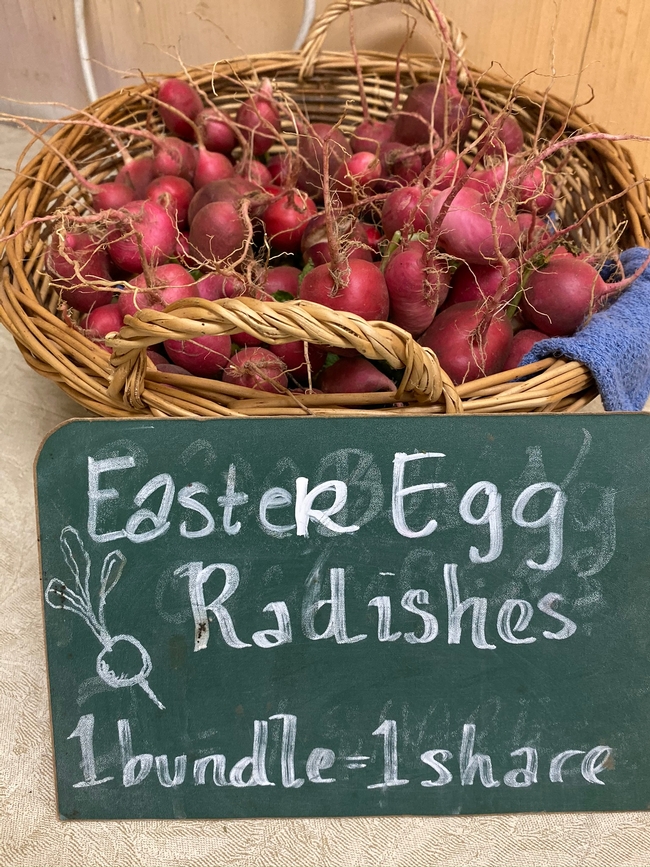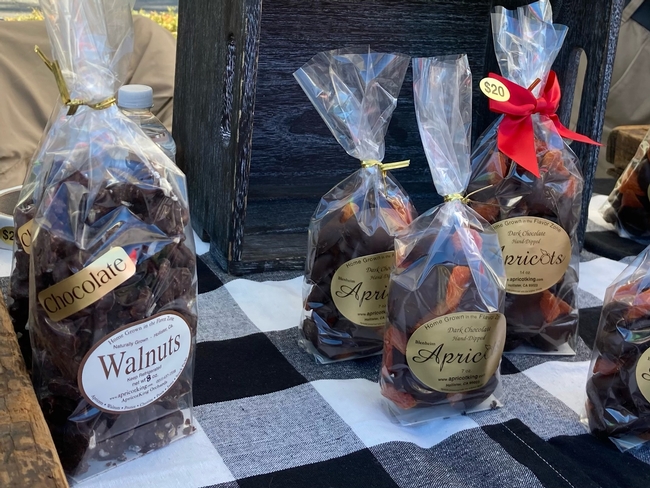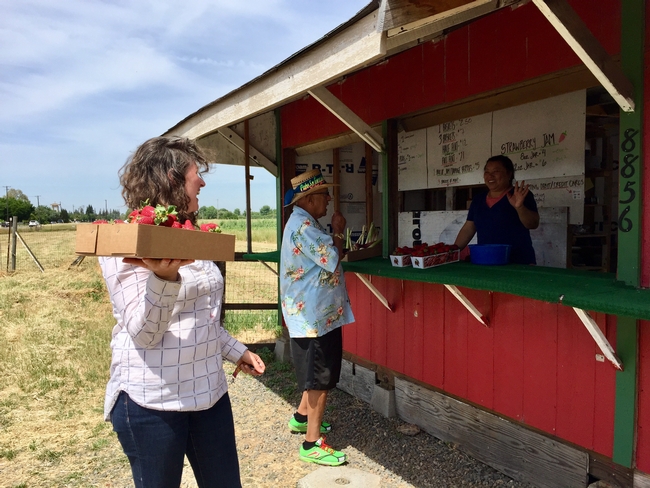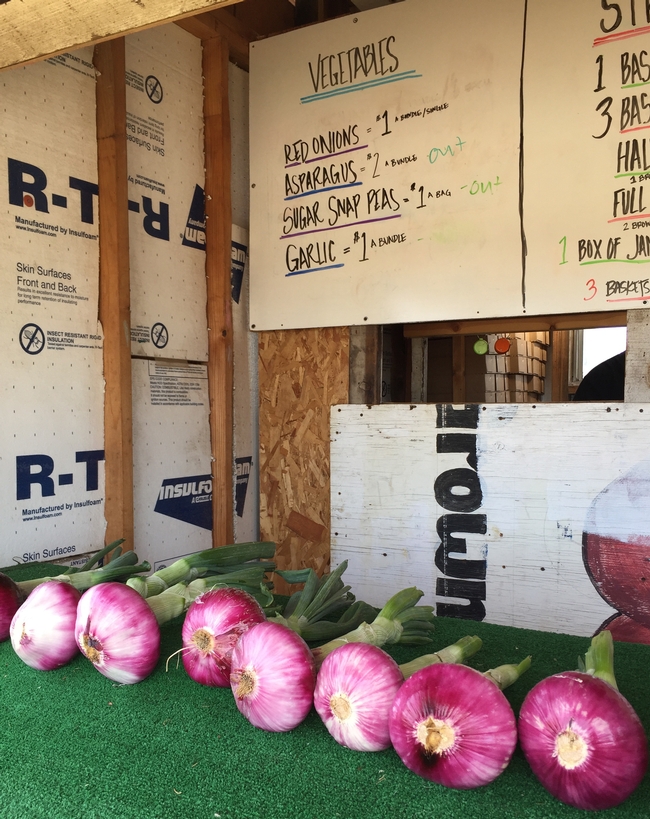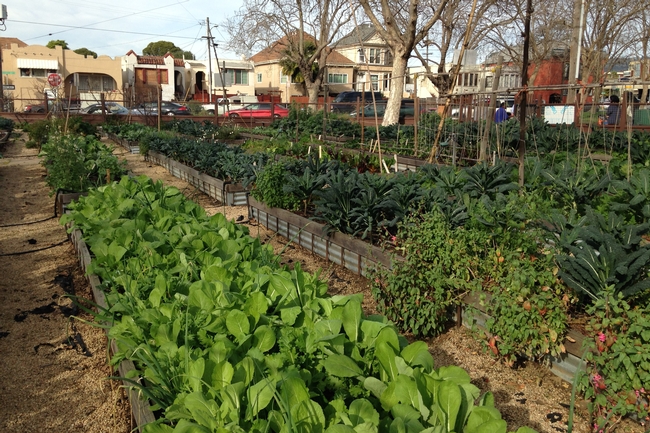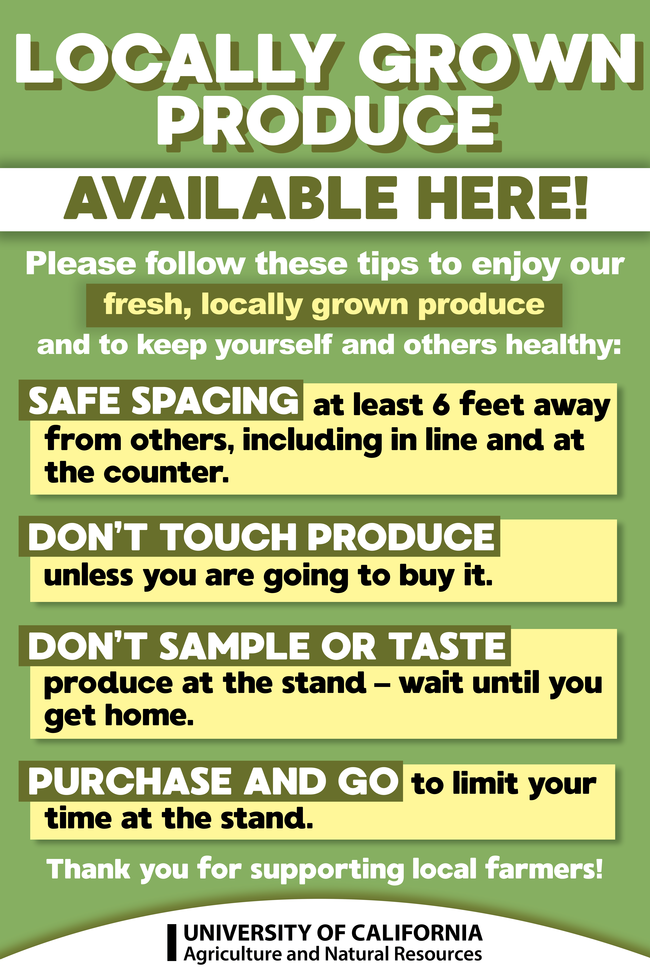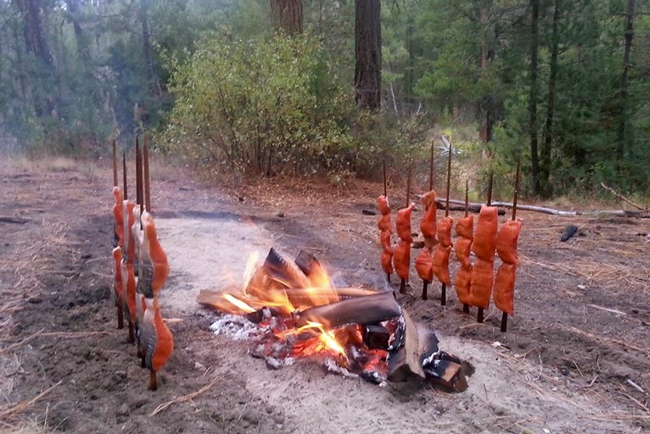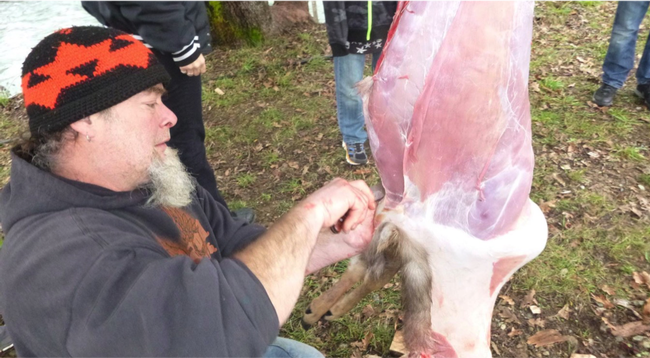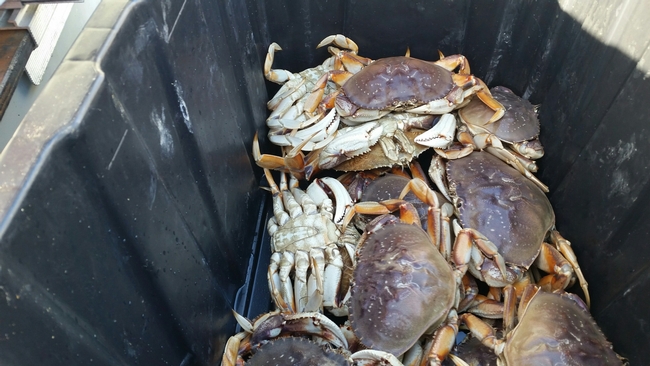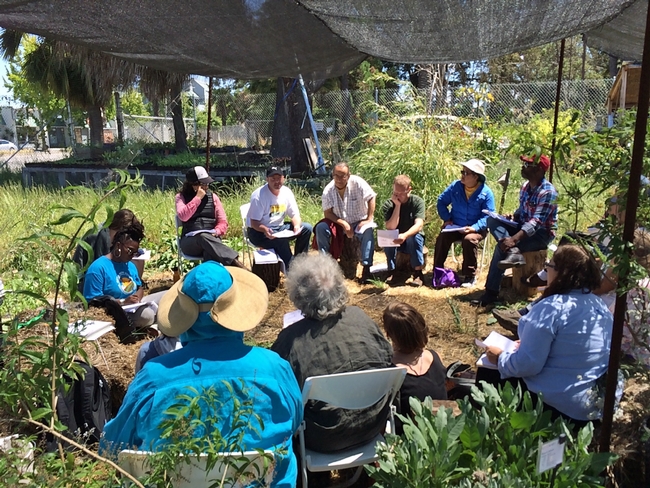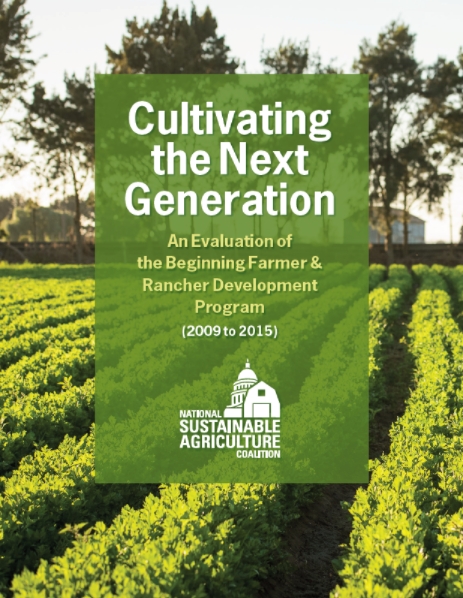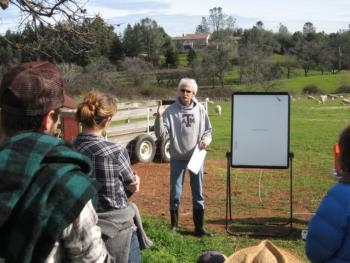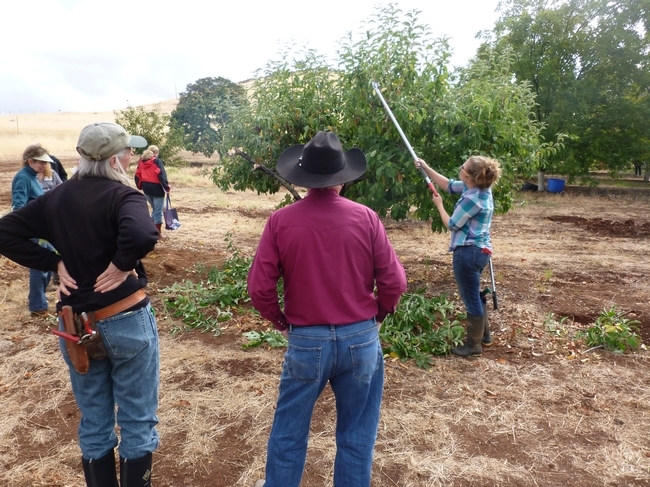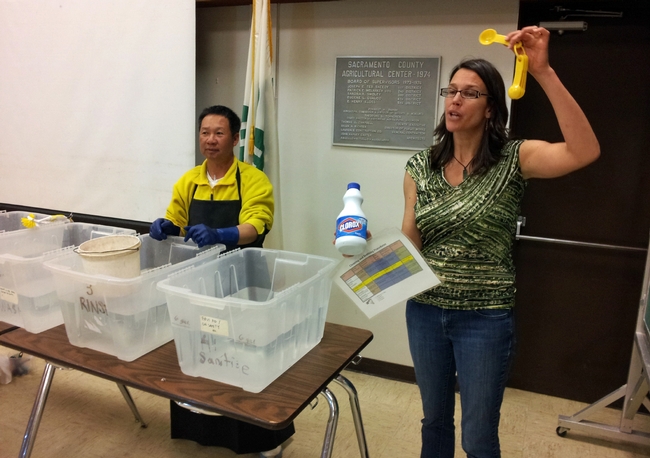Posts Tagged: Jennifer Sowerwine
Native people take a different view of Thanksgiving
The narrative that many people have been taught beginning in elementary school about the First Thanksgiving celebration in the United States is based on historically inaccurate myths that fail to acknowledge the devastation wrought by settler colonialism, including genocide, land theft, forced assimilation and cultural appropriation.
Many Native people refuse to celebrate Thanksgiving; some engage in a day of mourning, protesting the genocide wrought on their ancestors and ongoing oppression. Others pay respect to time-honored values and traditions centering on family, the earth and the harvest. As educators, it is important for us to understand the atrocities experienced by Native peoples at the hands of the European settlers, and Native perspectives about thanksgiving—a time of honoring the ancestors including the lands, plants and animals that are understood as relations—when we are communicating about the meaning of the Thanksgiving celebration.
Celebrations of harvest certainly did not originate with settlers and Native Americans sharing a meal in the 17th century, but rather have been integral to the fabric of Indigenous existence since time immemorial, noted UC Berkeley Professor Elizabeth Hoover (Mohawk/Mi'kmaq descent).
“For Haudenosaunee people (in the northeast), the Thanksgiving Address (Ohen:ton Karihwatehkwen, the Words that Come Before All Else) is recited before every important event,” Hoover said. “There are thanksgiving feasts held when the thunders start, when the sap flows, when it's time for the seeds to be planted, when the first wild strawberries come out, when the green beans are ready, when the green corn is ready, when the harvest is ready — many times throughout the year.”
Taking a decolonizing approach to Thanksgiving rejects the myths of Thanksgiving and harmful stereotypes about Native peoples that reinforce oppression, and invites opportunities for deepening our collective understanding of Indigenous history, amplifying Native perspectives that highlight the diversity of Indigenous peoples and foodways, and support Native-led food sovereignty and land stewardship initiatives that affirm contemporary presence and self-determination of Native people in 21st-century America.
UC Berkeley Professor Peter Nelson (Federated Indians of Graton Rancheria) offers this helpful insight: “We have plenty of points at which we give thanks for what our non-human relations give us or honor the changing of the seasons and gathering times. The fall in my language, Coast Miwok (Tamal Machchaw), is 'umpa walli or acorn time. Some of these concepts don't exactly translate from English. ‘Thank you,' or ka molis, means something more like I'm glad/happy. We express a state of being or how it makes us feel. The same is true of the concept of ‘I'm sorry,' which doesn't exist in our language. We have to contrive something to the effect of ‘my heart is sad,' ka wuskin sawa. Again, a state of being and there is a sense that you should just express how to fix things if they are out of sorts. Hearing a settler apology isn't enough. Do something about it.”
Consider centering Thanksgiving messaging around social and environmental justice by sharing resources for learning about the authentic history of Native Americans, contemporary Native American peoples and communities in both urban and rural areas, and supporting the growing Indigenous food sovereignty movement among Native Americans to reclaim and restore their food systems througheco-cultural restoration and self-determination.
The following are resources suggested by Elizabeth Hoover, Peter Nelson and others to learn more about the perspective of Native Americans on the U.S. holiday.
Decolonizing the history and meaning of Thanksgiving:
- Share these powerful short videos on Thanksgiving word association and Native people describing Thanksgiving that are helpful for understanding the Native American perspective on the holiday.
- View this brief speech by Linda Coombs (Aquinnah Wampanoag), who used to direct the Wampanoag Indigenous Program and Plymouth Plantation, at the site of the presumptive original Thanksgiving meal, for a greater perspective on the myths surrounding the origins of Thanksgiving.
- Also read this speech that Frank James attempted to deliver before the 1970 Pilgrim's Progress parade in Plymouth. His rejection after the organizers heard the content of his speech led to the National Day of Mourning counter-parade that takes place each year.
- This article, “The Thanksgiving Tale We Tell Is a Harmful Lie. As a Native American, I've Found a Better Way to Celebrate the Holiday,” is a helpful resource where Sioux Chef Sean Sherman makes the case for focusing Thanksgiving on values that apply to everybody: togetherness, generosity and gratitude, as well as embracing Indigenous foods, which are centrally featured in Thanksgiving meals including turkey, corn, beans, pumpkins, maple, cranberries, wild rice, etc.
- An excellent compilation of resources for youth and families by Lindsey Passenger Wiek, can be found in Decolonizing Thanksgiving: A Toolkit for Combatting Racism in Schools, that includes books, articles and inspirations for lesson plans, several of which are listed below.
- Helpful book suggestions and educational resources for teaching Thanksgiving in a socially responsible way, including lesson plans for all ages, are provided by the Southern Poverty Law Center at https://www.tolerance.org/magazine/teaching-thanksgiving-in-a-socially-responsible-way.
Learn about the Indigenous history of the United States and the Native lands and people where you live:
- Read Peter Nelson's Where Have All the Anthros Gone? The Shift in California Indian Studies from Research “on” to Research “with, for, and by” Indigenous Peoples.
- Spend some time researching the environmental and cultural history of the lands where you are standing starting with identifying whose lands you are residing in via this interactive map of Indigenous territories and learning about how you can support them.
- Learn about how the University of California and the other land grant institutions of higher education were founded upon the expropriation and sale of Indigenous lands that were “granted” to every state under the Morrill Act in this High Country News article and this UC Land-grab Workshop series. On this interactive map created by UC IGIS at https://arcg.is/1GTiuv, you can identify specific parcels that were “granted” and the Native communities from whom they were taken.
- Read The University of California Land Grab: A Legacy of Profit from Indigenous Land, a report based on the proceedings of the 2020 University of California Land Grab forum by Rosalie Zdzienicka Fanshel, Phenocia Bauerle (Apsaálooke), Deborah Lustig, and Jennifer Sowerwine. Executive summary
- Educate yourself about the history of Indigenous peoples and the American genocide in the United States, by reading Benjamin Madley's An American Genocide: The United States and the California Indian Catastrophe, 1846-1873i, Vine Deloria's 1969 Custer Died for Your Sins, Dunbar Ortiz's An Indigenous Peoples' History of the United States, or Dee Brown's classic Bury My Heart at Wounded Knee.
Learn about, support and amplify Native-led food sovereignty and land-stewardship initiatives in California:
- Watch the film Gather, featuring Indigenous chefs, scientists and activists around the country working to restore their spiritual, political and cultural identities through food sovereignty, including Samuel Gensaw (Yurok), co-founder of the Ancestral Guard, committed to restoring the foodways of North Coast California.
- Read about Indigenous foodways initiatives through Civil Eats reporting.
- Feature Native chefs in your communications such as Vincent Medina and Louis Trevino of Café Ohlone and Crystal Wahpepah to honor their Indigenous food heritage.
- Promote Native food purveyors, and other Native-owned businesses not only in November but year-round, as a way of honoring Native culture and ethical practices.
- Learn about and support Indigenous-led land stewardship efforts to restore cultural burning practices by the Karuk Tribe, the Amah Mutsun Land Trust, and the North Fork Mono Tribe, among others, to enhance healthy relationships with the land and mitigate against catastrophic fires that have devastated California communities and ecosystems.
- Read the First Nations Development Institute's report on California Indigenous land stewards for more information on both urban and rural Indigenous-led stewardship initiatives and Native perspectives across the state, including the Sogorea Te' Land Trust, an urban Indigenous women-led community organization that facilitates the return of Chochenyo and Karkin Ohlone lands in the San Francisco Bay Area to Indigenous stewardship.
- Read Elizabeth Hoover's blog about Native American farming and food sovereignty http://gardenwarriorsgoodseeds.com.
Honoring Native people and perspectives on Thanksgiving:
- In addition to reading, you may consider visiting a local Native American museum or cultural center during some part of the holiday (courtesy of Eve Bratman).
- Play the song Custer Died for your Sins and other songs of Indigenous resistance as music during your celebration. For starters, check out Rebel Beat Radio and Indigenous Resistance (courtesy of Eve Bratman)
- Take a moment of silence and remembrance for ancestors and the people whose land you are occupying, before your meal. Set intentions to learn more about and take action to support Native people.
Jennifer Sowerwine, UC Cooperative Extension specialist at UC Berkeley, and Sabrina Drill, UC Cooperative Extension advisor in Los Angeles and Ventura counties, collaborate with Native Americans on environmental and food sovereignty research.
New food-safety guide outlines laws and best practices for urban farmers
Californians growing food in cities now have help understanding the food safety laws that apply to them. A free publication containing California-specific information on rules and regulations for urban farmers was recently published by the University of California Agriculture and Natural Resources.
Growing fresh fruits and vegetables in community gardens, backyards and rooftops helps provide more food for urban communities, creates jobs and teaches people about the value of healthy foods, according to Jennifer Sowerwine, lead author and UC Cooperative Extension specialist at UC Berkeley.
"There are a growing number of backyard and community producers who are scaling up to sell some of what they grow,” said Rachel Surls, UC Cooperative Extension sustainable food systems advisor based in Los Angeles County and co-author. “We hope this guide will help them navigate the regulations and learn best practices for keeping food safe for consumers."
“California Urban Agriculture Food Safety Guide” provides urban food producers with an overview of food safety laws and regulations that may impact their operations. To help minimize the risk of contamination of foods during their production and exchange, it also provides best practices, or Good Agricultural Practices (GAPs).
"People donating produce grown or gleaned from urban environments will learn what laws may apply to them, and practical steps they can follow to minimize the risk of foodborne illness from urban-produced foods,” Sowerwine said.
The 72-page guide covers fresh produce safety, urban soils safety, as well as food safety considerations for eggs, poultry and small livestock in the urban environment. The authors also point out which aspects of the Food Safety Modernization Act apply to urban farms, California laws that apply, record keeping requirements, information on working with gleaners, how to register as a community supported agriculture (CSA) organization, permitting requirements, and how to develop a food safety plan.
Urban farmers can do a food safety assessment of their own farms using a check list included in the publication.
The guide was produced by Sowerwine; Christina Oatfield, Sustainable Economies Law Center policy director; Rob Bennaton, UC Cooperative Extension urban agriculture advisor; Alda Pires, UC Cooperative Extension in the UC Davis School of Veterinary Medicine; Surls; Valerie Borel, UC Cooperative Extension program representative; and Andre Biscaro, UC Cooperative Extension agriculture and environmental issues advisor.
The publication “California Urban Agriculture Food Safety Guide: Laws and Standard Operating Procedures for Farming Safely in the City” is available for free download at https://anrcatalog.ucanr.edu/pdf/8660.pdf.
Urban ag supplies fresh fruits and vegetables, part of a healthy diet
Even as Californians shelter in place to contain the novel coronavirus that causes COVID-19, nutritious food remains vital to the health and well-being of our communities.
“Eating fruits and vegetables is known to benefit our overall health and help our immune system,” said Lorrene Ritchie, director of the UC Nutrition Policy Institute. “At a time when we need to be especially vigilant about staying healthy, eating healthy is essential.”
Farms, farm stands and farmers markets are listed as “essential businesses” in the state shelter-in-place order because they are important parts of the food supply. Urban farms are included in this category. As large produce distributors struggle to switch from selling large quantities to restaurants, schools and institutions to supplying supermarkets, these small businesses may offer a better selection of fresh foods, and may be closer to homes and less crowded.
To help minimize exposure and risk of spreading of the virus, urban farms need to follow some key guidelines from the CDC , said Jennifer Sowerwine, UC Cooperative Extension metropolitan agriculture and food systems specialist in the Department of Environment, Science, Policy and Management at UC Berkeley.
UC Cooperative Extension has compiled a list of resources for farmers, community gardeners and other people working in the food system to ensure that they can continue supplying fresh, healthy and affordable food to Californians.
“Social distancing, heightened health and hygiene practices and cleaning and disinfecting reduce the risk,” said Sowerwine.
Although eating a nutritious diet can boost our immunity, the Los Angeles Times reported produce sales plummeted by 90% or more at Southern California produce markets after the statewide shelter-in-place rules went into effect.
“It's worrisome to see that sales of fruits and vegetables are dropping so sharply, but not surprising,” said Rachel Surls, UC Cooperative Extension sustainable food systems advisor for Los Angeles County. “As people shop during the crisis, they may be prioritizing groceries that can be stored for a longer time in the fridge or pantry. And they may be on a very limited food budget, even more so than usual, so they are likely prioritizing essentials like bread and rice and baby formula.”
To support farmers in California, the UC Sustainable Agriculture Research and Education Program created a directory at http://www.calagtour.org for consumers to find local farms to purchase produce directly.
For families who have lost jobs and income, the risk of food insecurity increases. Some families could supplement their food from gardens and urban agriculture during this crisis.
Consumers must practice safety, too, when visiting farmers markets and farm stands. UC Cooperative Extension small farm advisor Ruth Dahlquist-Willard explained, "Things like keeping the minimum six-foot distance from customers, not touching any produce that you're not planning to buy, leaving as soon as you've made a purchase and washing the produce when you get home would be some good guidelines."
The virus is thought to be spread mainly from person to person, however there is evidence that COVID-19 can last for days on hard surfaces, thus the need to ramp up good health and hygiene practices, social distancing and cleaning and sanitizing of surfaces.
University of California research and extension faculty have compiled a list of helpful fact sheets and resources for farmers, community gardeners and other food system workers to ensure fresh, healthy and affordable food for communities across the state:
- Food-related resources for consumers and members of the food industry for COVID-19
- on the UC Davis Food Safety website.
- Sowerwine's PowerPoint presentation Safe Handling Practices for Fresh Produce in a Time of Coronavirus Disease 2019 (COVID-19) for urban farmers.
- A set of policies and procedures for safe food handling at the farm during COVID-19 provides step-by-step instructions for applying new food and health precautions on the farm including checklists, standard operating procedures and signage posting guidelines for preventing the spread of infection.
- COVID-19 safety guidelines for farm stands.
- Handouts for safe food-handling at home that can be distributed to customers receiving food from the farm.
All of these resources are posted on the UC Urban Agriculture website at https://ucanr.edu/sites/UrbanAg.
“During this challenging time, I am heartened by the quick and thoughtful responses by many extension, grassroots and institutional efforts, including Community Alliance with Family Farm's COVID-19 Responses and Resources for California Family Farms, Mutual Aid organizations where groups of young, healthy and lower-risk people are bringing food and services to vulnerable people who shouldn't be in public at all, and Bayareafood.info that seeks to support local restaurants, farmers, and food systems workers as they weather this latest storm,” said Sowerwine. “Crisis can spawn innovation, and I am hopeful that through this, we will come out the other end with a more compassionate and resilient food system.”
With access to native foods, Native American families less likely to face food insecurity
Native Americans suffer from the highest rates of food insecurity, poverty and diet-related disease in the United States. A new study finds that Native American communities could improve their food security with a greater ability to hunt, fish, gather and preserve their own food.
“How food security is framed, and by whom, shapes the interventions or solutions that are proposed,” said Jennifer Sowerwine, UC Cooperative Extension specialist at UC Berkeley, who led the study in partnership with the Karuk, Yurok, Hoopa, and Klamath Tribes. “Our research suggests that current measures of and solutions to food insecurity in the United States need to be more culturally relevant to effectively assess and address chronic food insecurity in Native American communities.”
The study conducted by researchers at UC Berkeley and four Native American tribes shows that 92% of Native American households in the Klamath Basin suffer from food insecurity.
Native American tribes in the Klamath Basin seasonally harvest, consume and store diverse aquatic and terrestrial native foods including salmon, acorns and deer. In survey responses, 86% of the participants said they consumed native foods at least once in the previous year. Yet significant barriers, including restrictive laws and wildlife habitat degradation, limit availability and quality of these foods.
While 64% of Native American households in the Klamath Basin rely on food assistance (compared to the national average of 12%), 84% of the Native Americans using food assistance worried about running out of food or had run out of food. This suggests the need to consider more effective solutions rooted in eco-cultural restoration and food sovereignty to address food insecurity in Native American communities.
Study participants strongly expressed the desire for strengthened tribal governance of Native lands and stewardship of cultural resources to increase access to native foods, as well as strengthening skills for self-reliance including support for home food production. Community members suggested solutions including tribe-led workshops on native foods gathering, preparation and preservation; removing legal barriers to hunt, fish and gather; restoring traditional rights to hunt, fish and gather on tribal ancestral lands; providing culturally relevant education and employment opportunities to tribal members; and increased funding for native foods programs.
While growing evidence suggests that native foods are the most nutritious and culturally appropriate foods for Native American people – and over 99% of people surveyed in the region said they want more of these foods – nearly 70% said they never or rarely get access to the native foods they want.
“We know our efforts to revitalize and care for our food system through traditional land management are critical to the physical and cultural survival of the humans who are part of it,” said Leaf Hillman, program manager for the Karuk Tribe's Píkyav Field Institute. “This study will support our ability to bring that message to the decisionmakers who need to hear it.”
With the study results indicating that increased access to native foods and support for cultural institutions such as traditional knowledge and food sharing are key to solving food insecurity in Native American communities, Sowerwine and the research team propose including access to native foods as a measure for evaluating food security for Native people.
The assessment is based on 711 surveys completed by households from the Karuk, Yurok, Hoopa and Klamath Tribes, 115 interviews with cultural practitioners and food system stakeholders, and 20 focus groups with tribal members or descendants.
In addition to Sowerwine and Hillman, the study was conducted by post-doctoral researchers Megan Mucioki and Dan Sarna-Wojcicki, and research partners from the Yurok, Karuk and Klamath Tribes.
“Partnering with tribal community members in the research makes the research stronger, and that is especially true in this unique food security assessment,” said Sowerwine. “With the study design grounded in nearly a decade of relationship-building and respectful engagement with our tribal partners, we are confident that our results reflect their priority questions and concerns while contributing valuable new information to the field of indigenous food systems.”
“Reframing food security by and for Native American communities: a case study among tribes in the Klamath River basin of Oregon and California” is published in the journal Food Security.
This research was part of a $4 million, five-year Tribal Food Security Project funded by USDA-National Institute of Food and Agriculture-Agriculture and Food Research Initiative Food Security Grant #2012-68004-20018. For full results and recommendations from the project team, visit https://nature.berkeley.edu/karuk-collaborative/?page_id=1088.
Investment in training new farmers is paying off
Training people to farm is successfully preparing them for careers, according to a new report from the National Sustainable Agriculture Coalition. Their report, “Cultivating the Next Generation,” evaluates the U.S. Department of Agriculture's (USDA) Beginning Farmer and Rancher Development Program, which was funded in the 2008 Farm Bill.
Since 2008, USDA has invested roughly $150 million in more than 250 new farmer training projects across the country.
According to a national survey, Beginning Farmer and Rancher Development Program-funded project leaders estimated that over half of their participants are now engaged in a farming career, and that nearly three-quarters of them felt more prepared for a successful career in agriculture after completing the program.
The Beginning Farmer and Rancher Development Program has also helped nonprofit and community-based organizations, along with their academic partners, to build their capacity and serve more farmers with better services.
In California, UC Cooperative Extension has been providing beginning farming and farm business planning training in Placer and Nevada counties for over a decade. In a 2016 survey of Placer and Nevada county producers, 72 percent of respondents said they had taken one or more business classes from UCCE and another 9 percent had taken other business training. The training appeared to make a difference in their success.
“In a survey of local producers, over 90 percent were profitable as compared to 25 percent on the last national ag census,” said Cindy Fake, director of UC Cooperative Extension in Placer and Nevada counties.
In Sonoma County, UC Cooperative Extension offers "FARMING 101" workshops on the second Tuesday of the month. Experienced farmers, ranchers, and business specialists share a broad range of practical skills that new farmers and ranchers need to know. They also have resources at http://cesonoma.ucanr.edu/New_to_Sonoma_County_Ag to help new farmers and ranchers create a business plan and connect with mentors.
“For me, the full-time job I received is the direct result of my participation in the class,” wrote one Sonoma County participant. “Our products there provide 20 dozen eggs to three restaurants weekly in Healdsburg, and an average of 60 tons of wine grapes to two wineries annually.”
Jennifer Sowerwine, UC Cooperative Extension specialist at UC Berkeley, served on an advisory board for the USDA program's evaluation. The report gave her ideas for improving training for California's aspiring farmers and ranchers.
“There is an opportunity for UC ANR to take more advantage of Beginning Farmer and Rancher Development Program funding to increase our support for beginning farmers and ranchers,” said Sowerwine.
According to the report, more beginning farmer training programs are led by the nonprofit sector than by land grant universities – 56 percent of all programs were led by nonprofits, 40 percent were led by land grant universities and 4 percent were led by other universities.
“There is an opportunity to deepen UC ANR support for beginning farmers in accessing land, capital and farm business management training,” Sowerwine said. “In addition to UC ANR's valued expertise in providing technical assistance to beginning farmers, we can also foster more farmer-to-farmer mentoring and networking opportunities for beginning farmers and ranchers to enhance their support systems.”
She also sees opportunities to incorporate more principles of adult education – such as engaging participants in the design and evaluation of the training and offering more hands-on, experiential learning activities using multisensory techniques – which were found to be highly effective practices in training beginning farmers.
Sowerwine is wrapping up a three-year beginning farmer and rancher project titled, "Growing Roots: Deepening Support for Diverse New Farmers and Ranchers in California.” Christy Getz, UC Cooperative Extension specialist at UC Berkeley, and Rob Bennaton, UC Cooperative Extension urban agriculture advisor, and Sowerwine, together with their nonprofit partners, have trained 340 beginning farmers and ranchers in 10 counties to help improve the economic viability and ecological sustainability of their agricultural operations.
The training is offered in Alameda, Contra Costa, Fresno, Merced, Monterey, Sacramento, San Joaquin, Santa Clara, Stanislaus and Yolo counties. Most of the participants are Southeast Asian, Latino and other immigrant farmers in urban, peri-urban and rural areas, along with low-income urban farmers.
By partnering with National Center for Appropriate Technology, Sustainable Agriculture Education, the Alameda County Resource Conservation District and UC Cooperative Extension colleagues in Alameda and Contra Costa counties, the team has been offering in-depth, culturally and regionally appropriate workshops and technical assistance. They also developed materials about business planning and marketing, hosted field days and farmer tours to observe organic and sustainable farming and ranching practices, and provided opportunities for the new farmers to network with other farmers.
“Collectively our project has reached 5,050 participants to date,” Sowerwine said, noting that many are people who have attended multiple events. Of the 3,485 who filled out evaluations, 89 percent reported an increase in their knowledge of workshop and field day topics and 73 percent reported plans to change their farming or business practices based on what they learned.
“We are in the process of evaluating how many have adopted practices based on what they learned,” Sowerwine said. “Based on what we learned, we are developing culturally relevant training tools in various languages.”
To download the Cultivating the Next Generation report, visit http://sustainableagriculture.net/publications/bfrdp.


